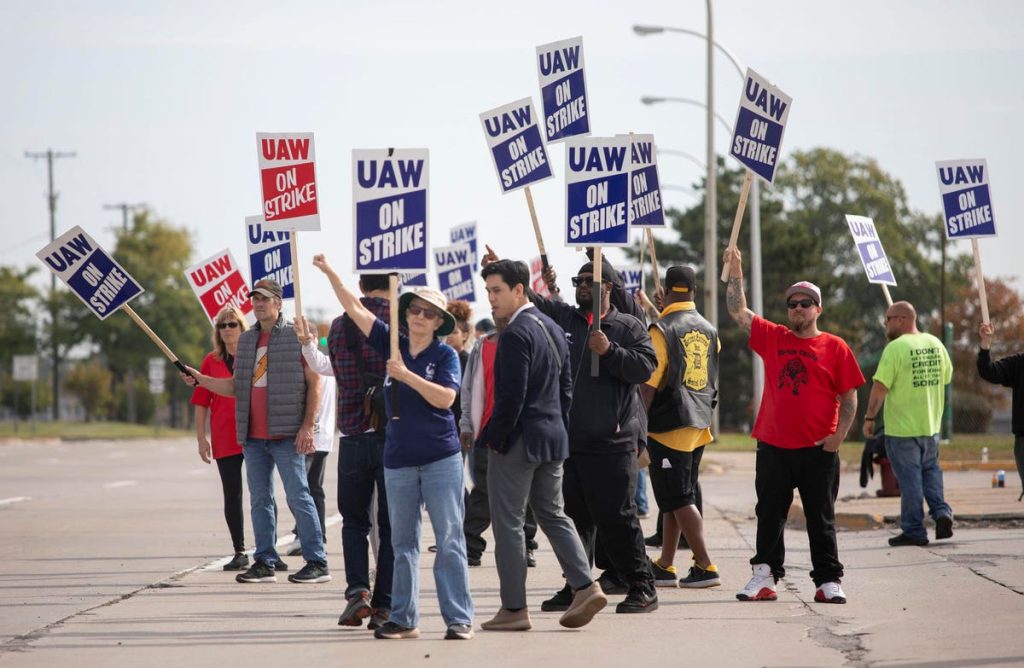When the Detroit-based United Auto Workers launched its strike against the big three automakers before the stroke of midnight Thursday, it was working from a new playbook.
Understandably, the main headline was how the union went on strike against all three companies, General Motors Co., Ford Motor Co., and Stellantis (which includes the former Chrysler Corp.) at once. Traditionally, the UAW selected a “target” automaker. The union concentrated its efforts on the target, then sought to extend the basic terms of an agreement to the other two.
This time out, the union under new President Shawn Fain, the UAW didn’t designate a target company. The union bargained with all three companies simultaneously. When no agreement materialized, the UAW had members walk off the job at one factory for each automaker. The facilities involved make highly profitable vehicles. The UAW said without settlements the strikes would expand.
Twenty years ago, during the 2003 negotiations, the UAW conducted simultaneous talks with the three companies but things played out differently.
There were media reports the union would announce three agreements at once. That didn’t happen. There was an accord with the then-DaimlerChrysler, followed by an agreement with Ford 24 hours later. GM had a settlement before the end of the week. No strikes occurred.
The UAW also has conducted selective walkouts before. But they took place between general contract negotiations. To put pressure on a particular automaker, the UAW would declare there were health and safety violations at key factories.
For example, in the 1990s, GM had a health and safety strike at an Indianapolis metal-stamping plant that supplied multiple vehicle-assembly plants. The union also conducted a brief strike at a Kokomo, Indiana, complex that supplied automatic transmissions to multiple assembly plants. Such selective strikes would quickly cause financial pain at the automakers affected.
UAW chief Fain, essentially, updated that strategy to this year’s general contract negotiations.
Perhaps the biggest change for the UAW this year was its messaging.
Some previous union presidents, such as Stephen Yokich and Ron Gettelfinger, had little use for reporters. They rarely gave interviews and didn’t want union officials talking to the media. Automakers, not wanting to antagonize the union, kept mum about negotiations.
Fain adopted 21st technology. He conducted livestreams on the union’s Facebook page and gave interviews on outlets such as CNBC. That forced automaker executives to respond with statements and produce negotiation videos of their own.
The union president, in one of his livestreams before this year’s strike, urged union members to talk to reporters to tell their stories.
To be sure, there’s a lot at stake for both the UAW and the automakers.
Fain has raised expectations for union members with tough talk. He has said repeatedly that UAW members gave up a lot after GM and Chrysler went into bankruptcy in the 2000s. He referencee how much automaker executives make in compensation compared with union members.
The automakers rebounded from the bankruptcies and produced a lot of profit. But the industry is shifting, under regulatory pressure, to electric vehicles. The companies are counting on profits from their traditional vehicles to finance the shift to EVs.
What’s more, the change to EVs will drastically change the factory floor. EVs generally have fewer moving parts than traditional internal combustion engines. Assembling EVs is different than traditional cars and trucks. There is, understandably, concern among auto workers how that change will shake out.
Still, however this three-company turns out, the UAW’s tactics are much different than the past.
Read the full article here








